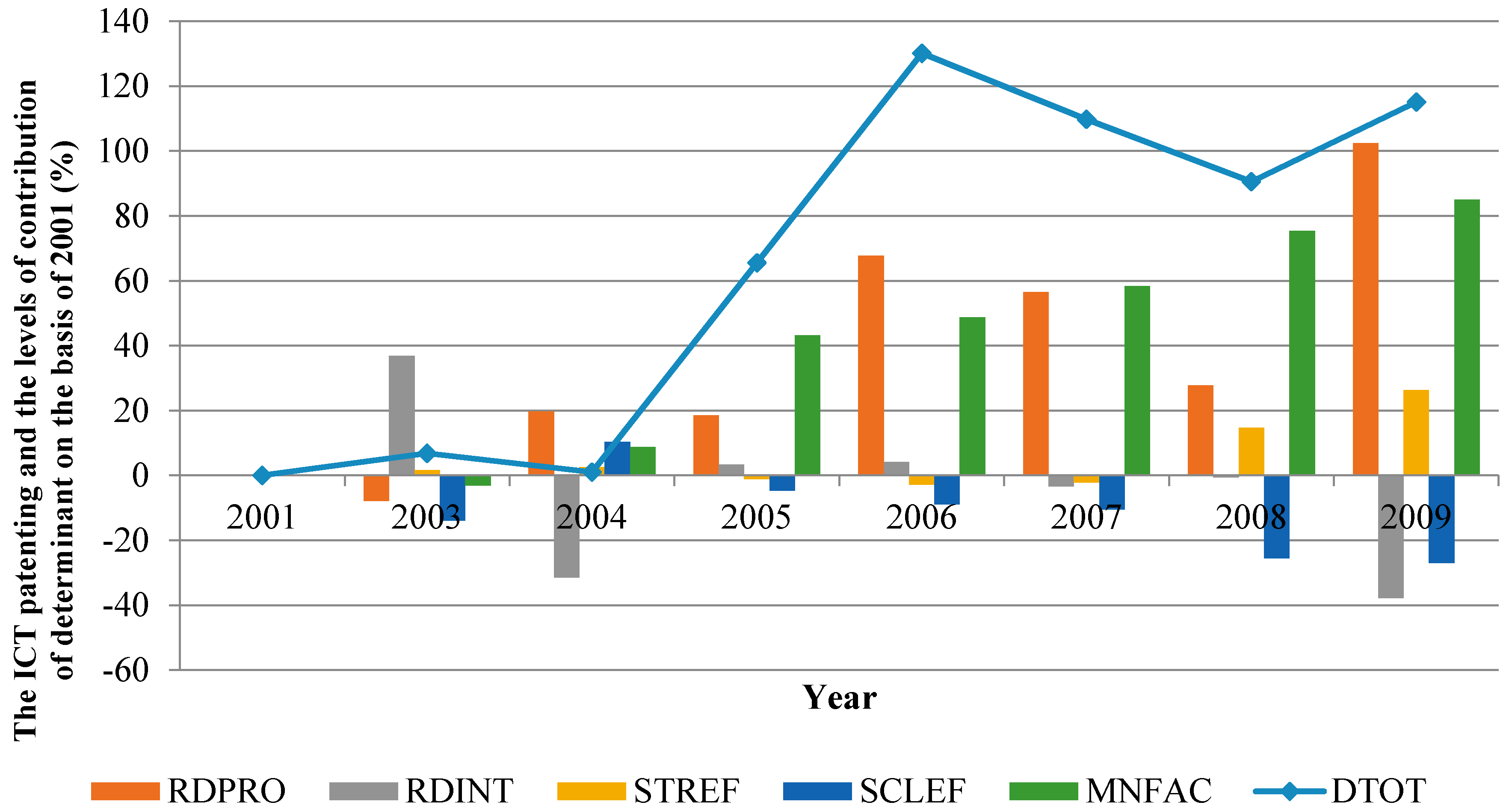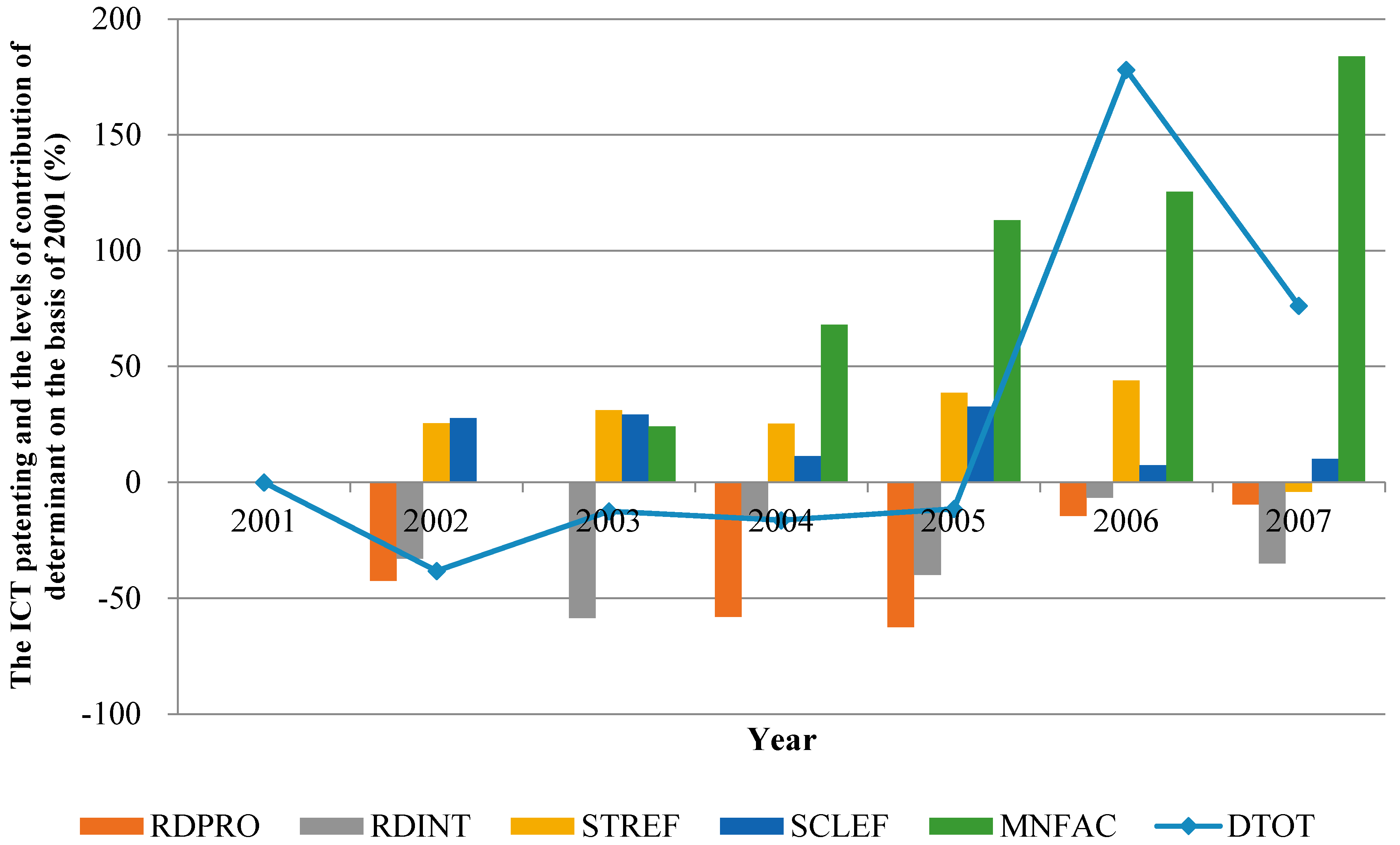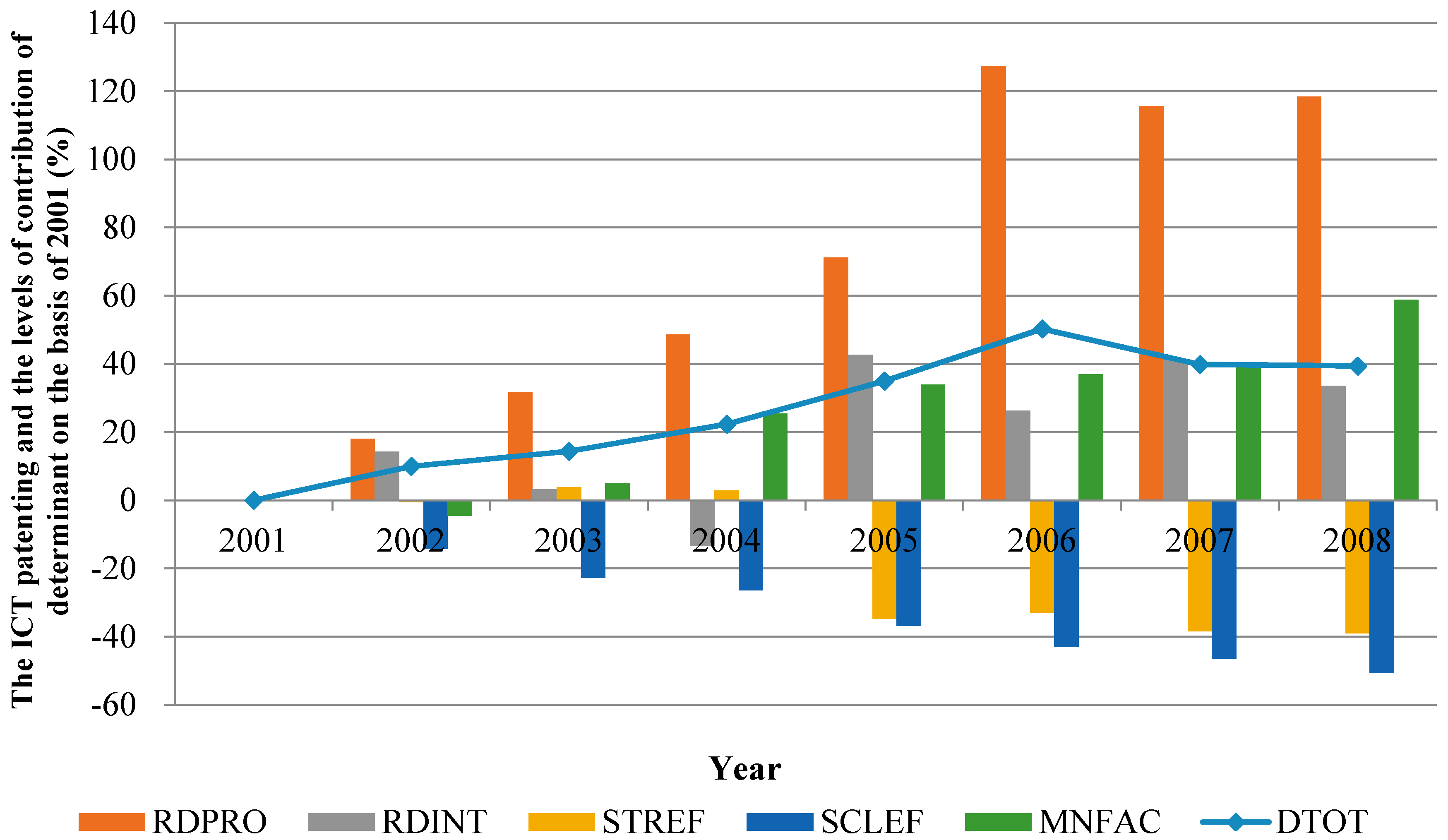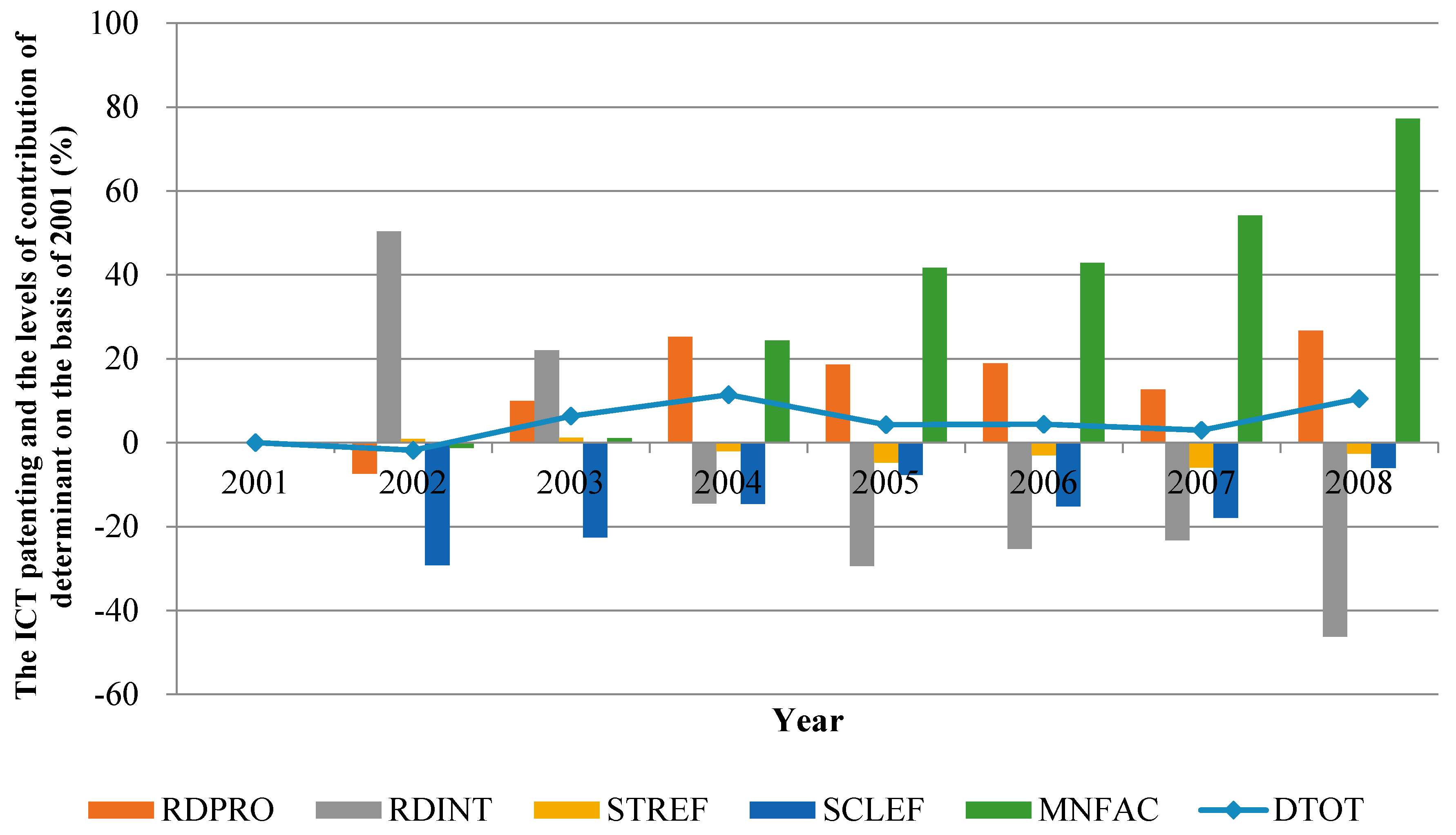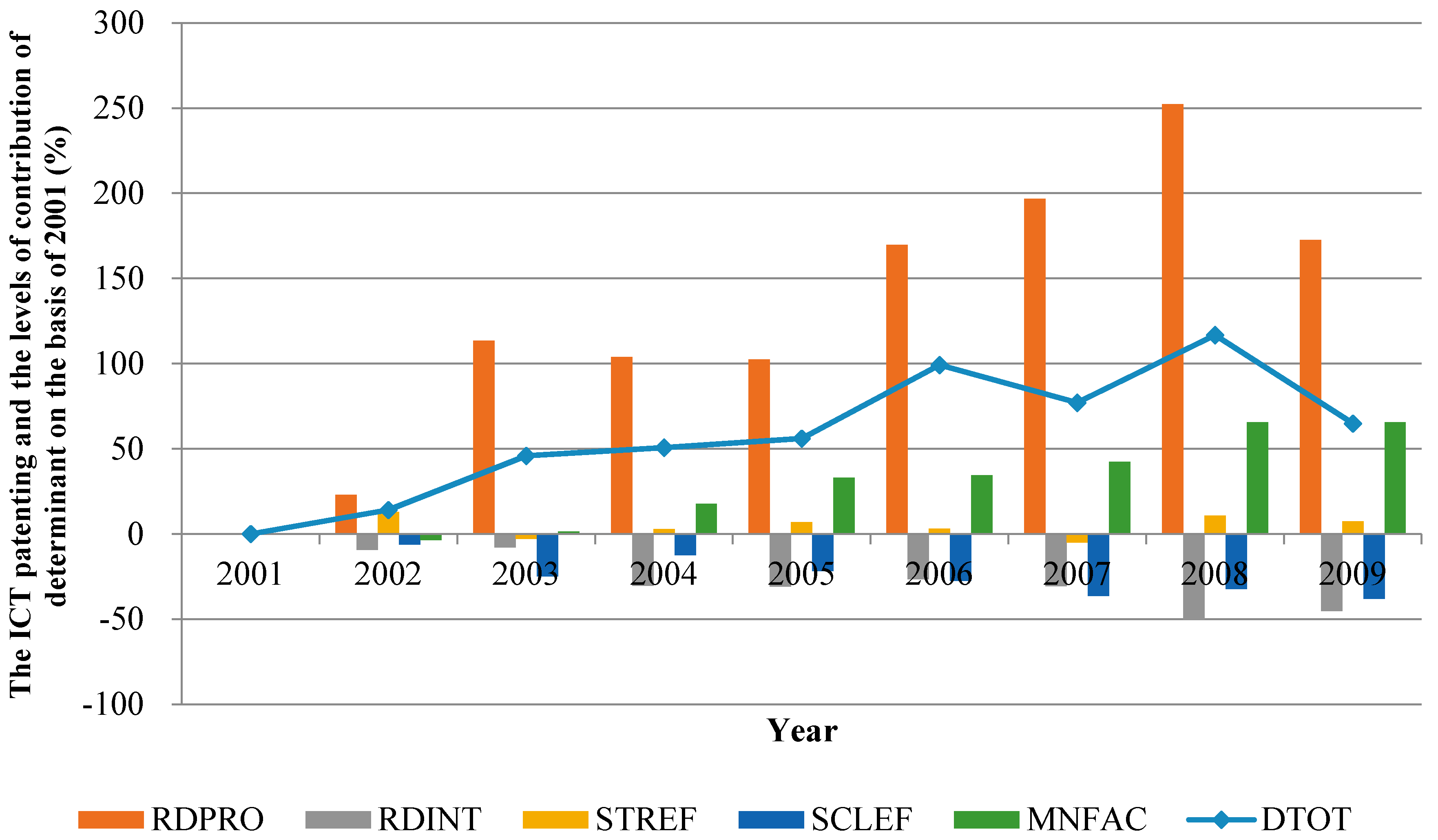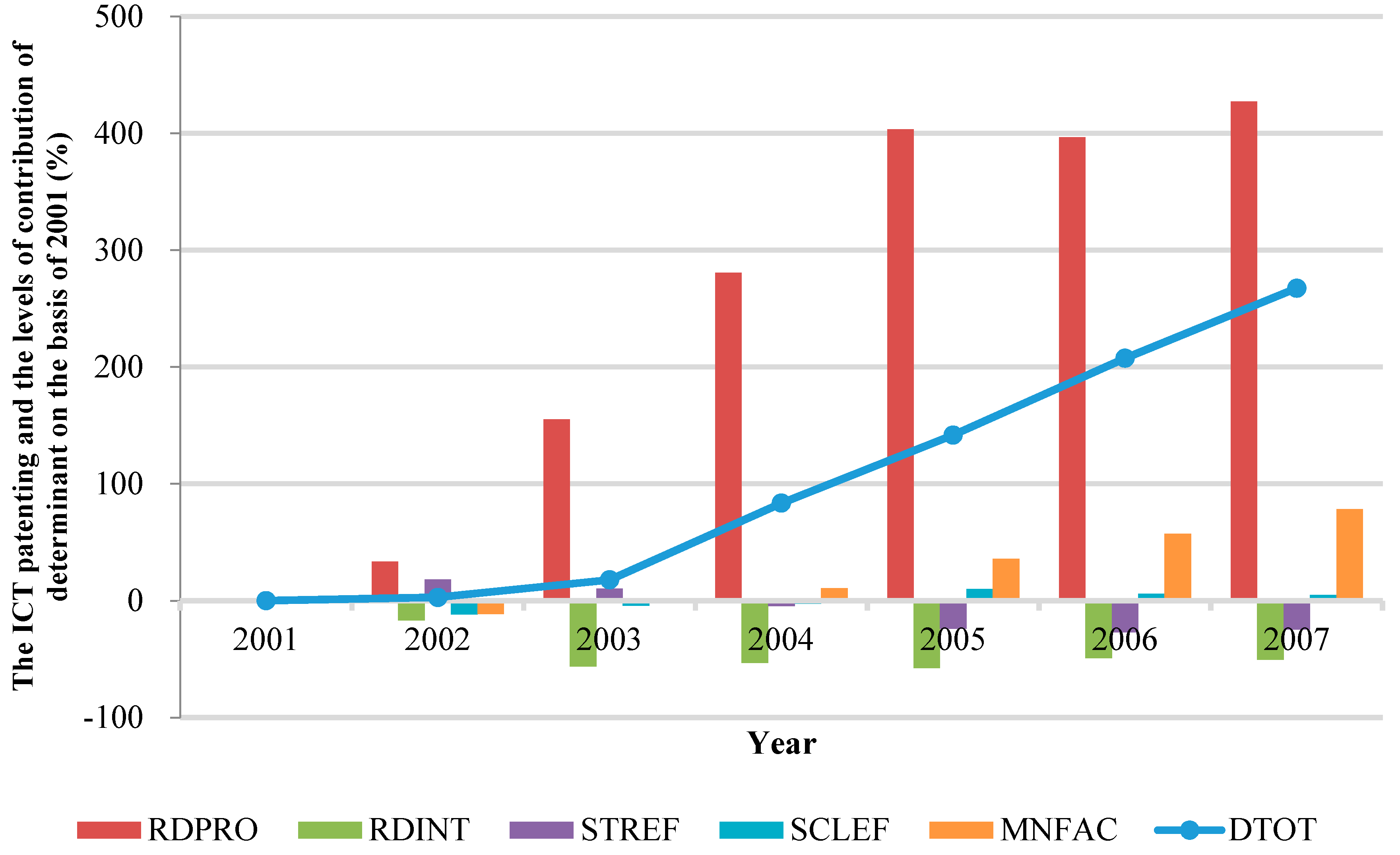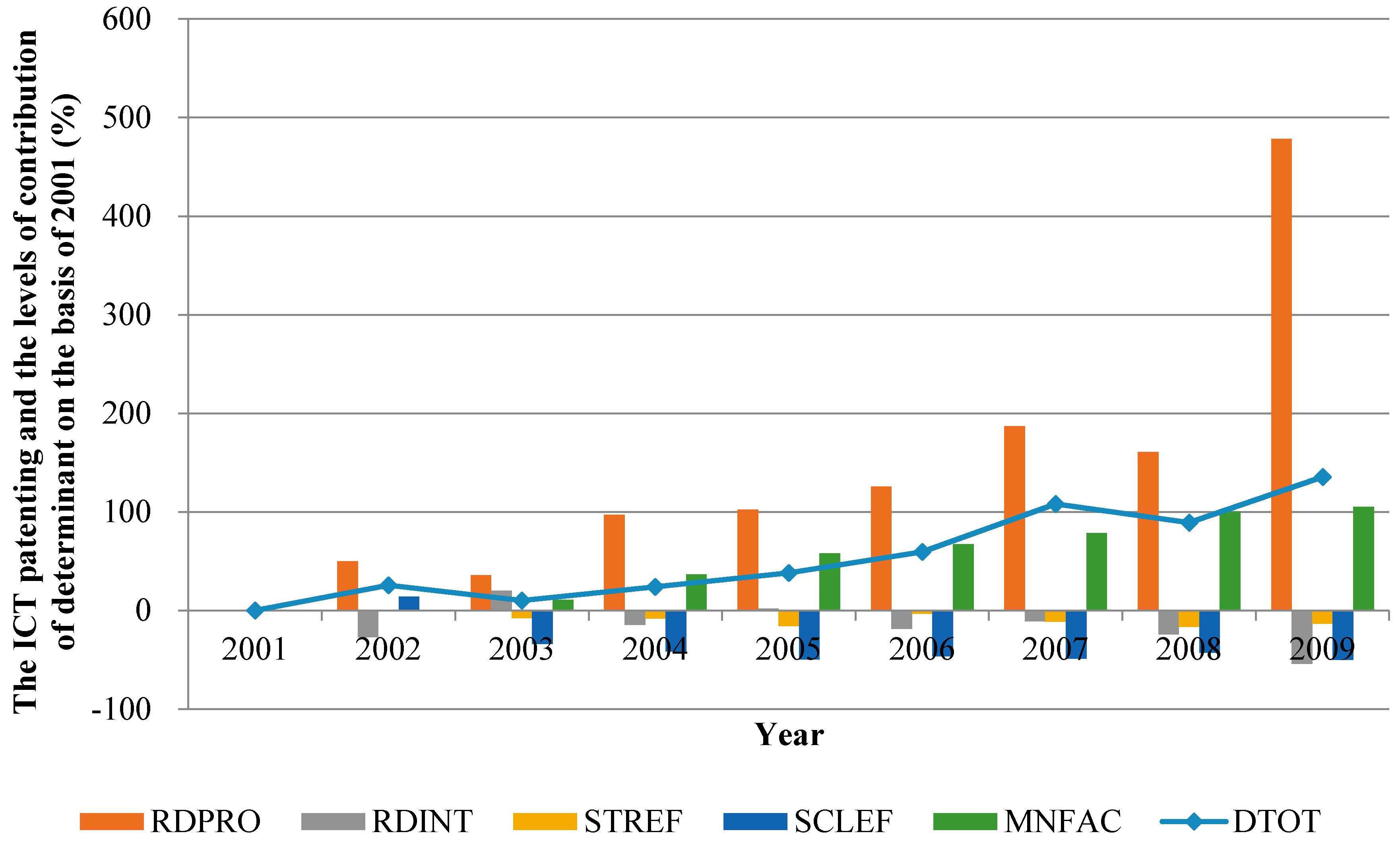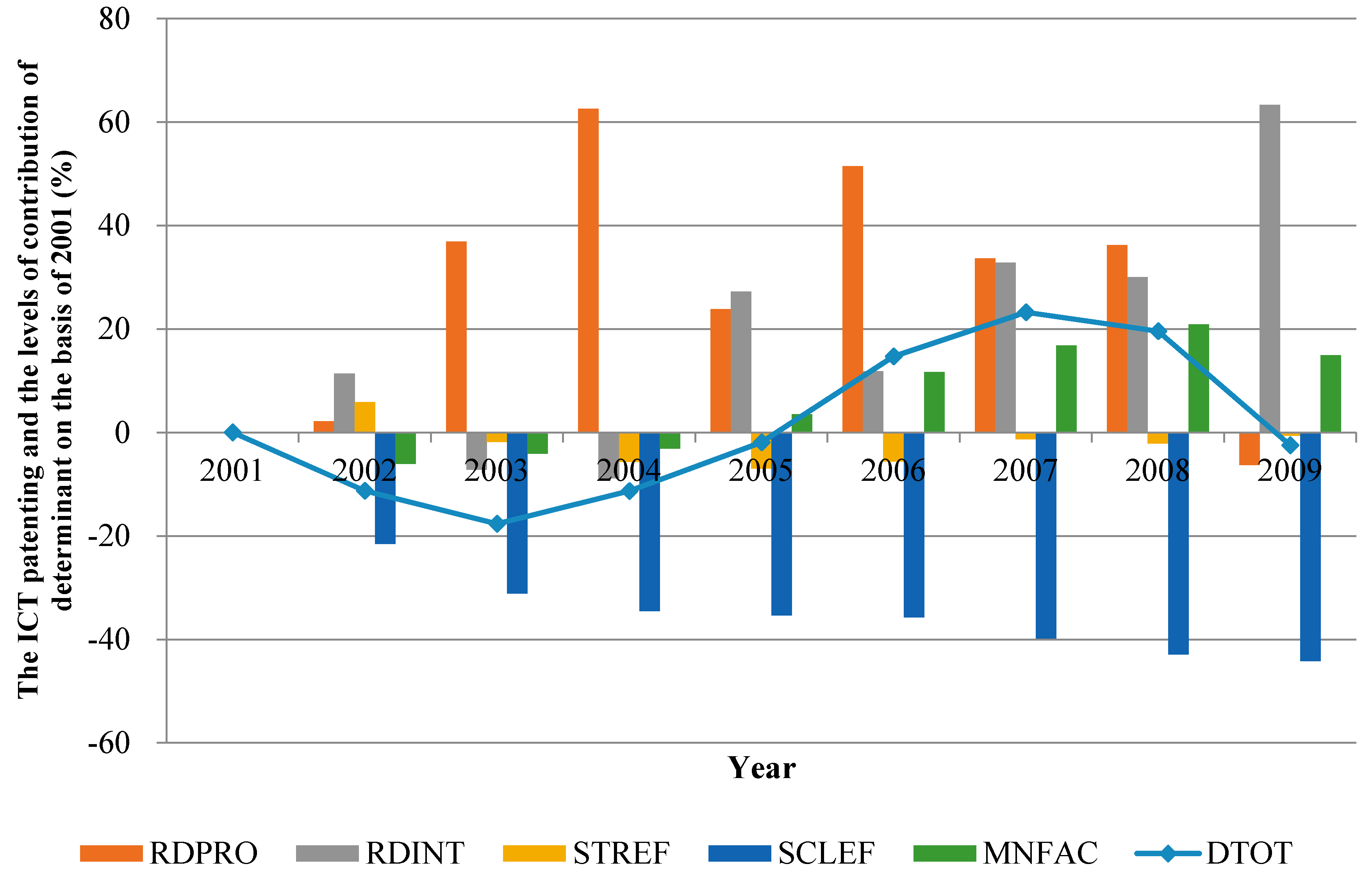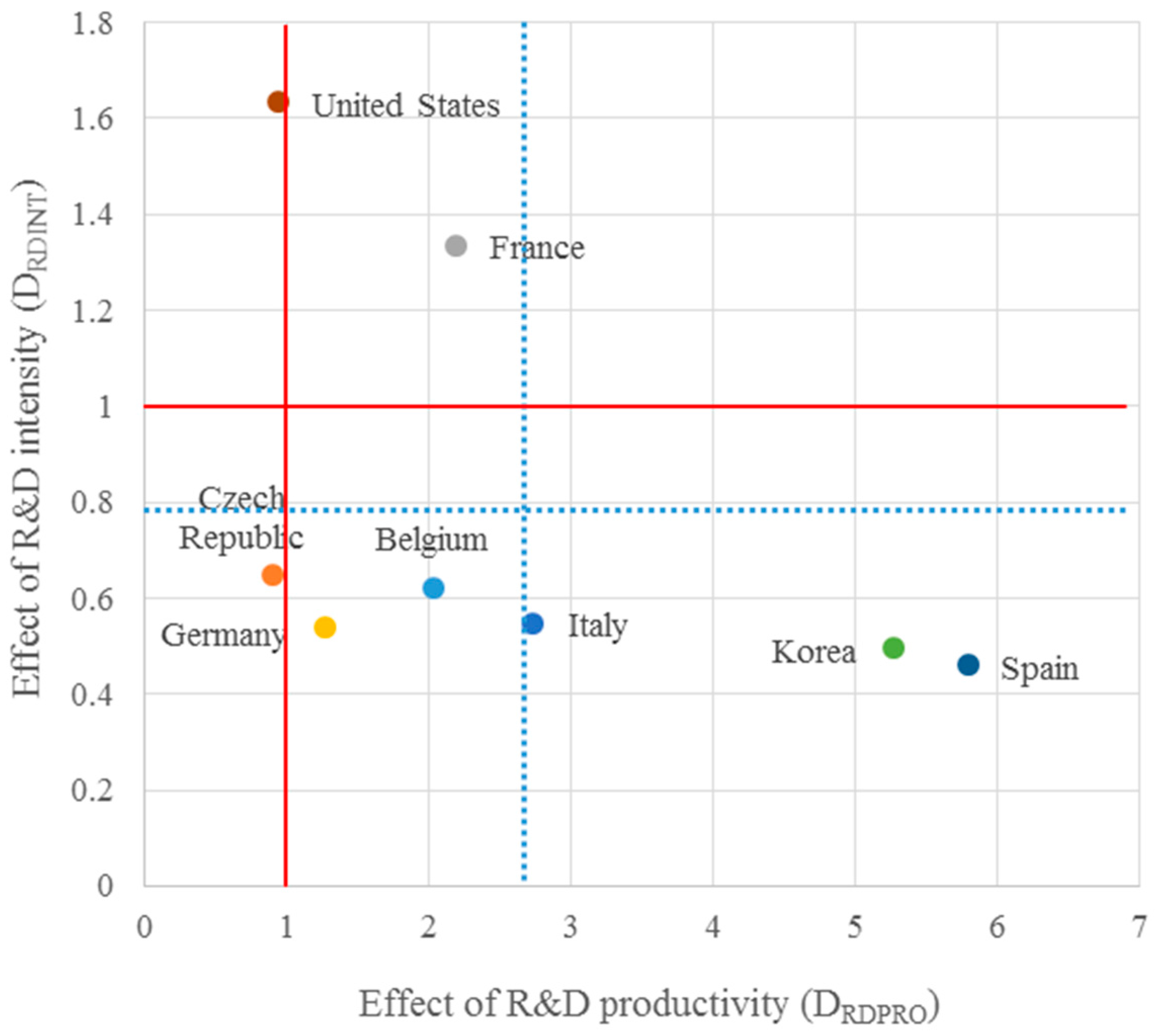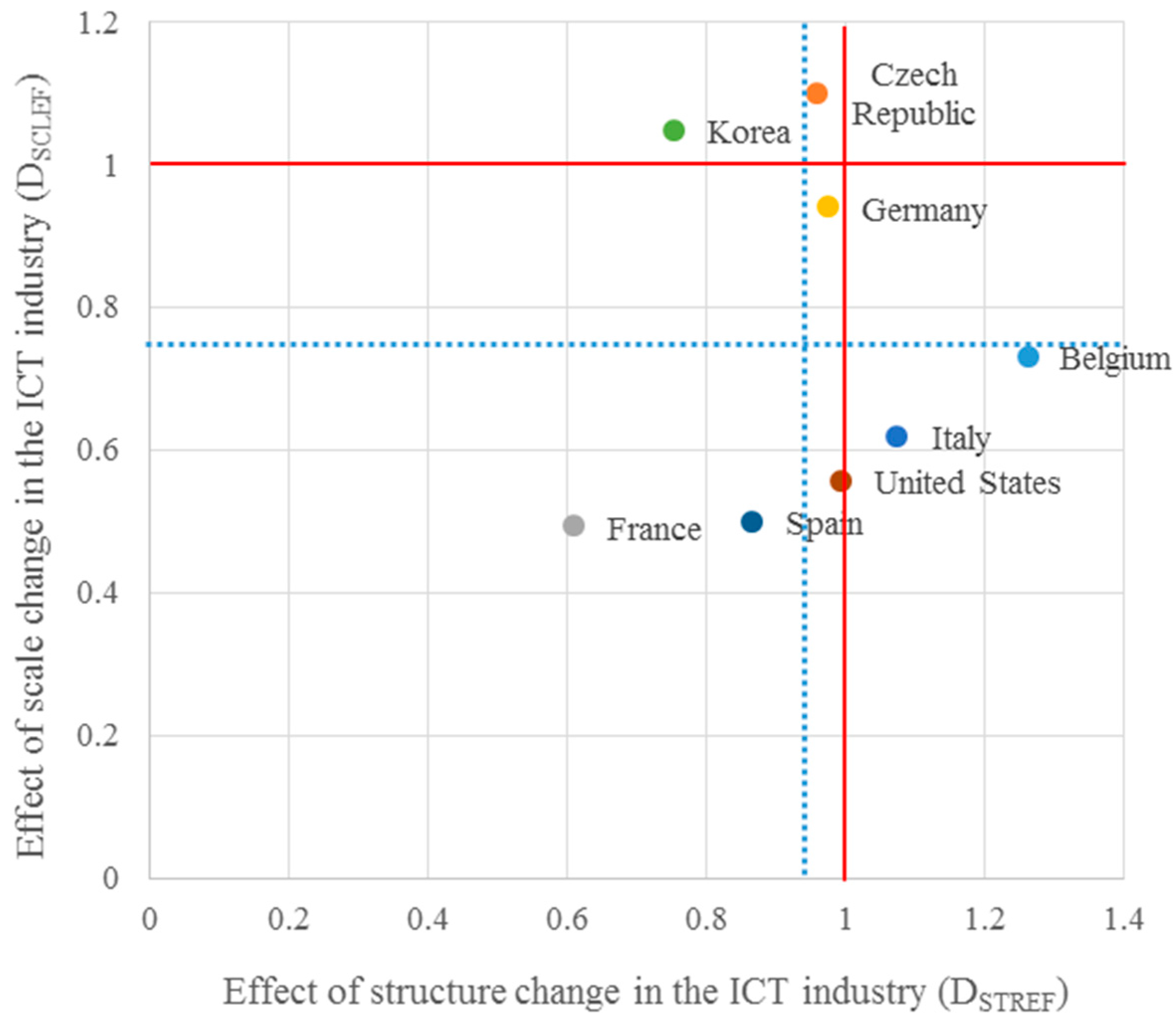1. Introduction
The innovation policies of major developed countries generally focus on establishing a mission-driven innovative ecosystem which is related to business development and job creation due to recent economic recession trends. This ecosystem’s creation is also emphasized to enhance the efficiency and outcome quality in research and development (R&D) through performance evaluation management and inspection reinforcement, rather than new investment expansion. An in-depth analysis of R&D outcomes has become increasingly important for this reason.
The extent of R&D outcomes can normally be measured by using R&D expenditure data or the patent’s bibliographic information. As patent documents in particular contain much detailed information regarding the technology itself, the information in the patent document can be widely considered to be an index representing the size of technological activity and the invention process [
1,
2,
3]. Thus, many academic papers have used patents as a proxy to represent the size of R&D outcomes (in a narrow sense), technological innovation and knowledge creation (in an extended meaning) [
1,
2,
3,
4,
5,
6,
7,
8,
9,
10,
11].
Interest in them was primarily to empirically reveal whether, or even how, technological innovation and R&D outcomes could affect firms’ productivity, market and industry structures, and even a country’s economic growth [
12,
13,
14,
15]. Meanwhile, some other previous papers focused on how the external relationship with firms’ productivity, market and industry structures, and a country’s economic growth has adversely affected R&D outcomes, and furthermore, technological innovation [
9,
16,
17,
18,
19,
20,
21]. However, these studies focused on using the patenting activity as an instrumental variable for innovation but did not look in-depth at the changes in the patenting activity itself.
Thus, recently, it has been attempted to analyze the core factors contributing to innovation outcomes in the manufacturing industry using the non-parametric method, especially decomposition analysis which can accommodate various economic indicators. Although decomposition analysis has been typically applied to analyze energy consumption trends and greenhouse gas emissions at national and industrial levels [
22,
23,
24,
25,
26,
27,
28,
29,
30,
31], it is starting to be widely utilized in recent years to evaluate the impact of other social factors influencing certain phenomena [
32,
33,
34,
35,
36,
37,
38,
39].
Kim and Marschke (2004) [
33] determined changes in patent applications for the United States’ manufacturing industry from 1983 to 1992, and decomposed patenting changes into R&D expenditures and R&D productivity (the patent–R&D ratio) at the industry level. Their analysis revealed that computer hardware, electricity, and information and communication technology (ICT) devices led to patenting activity growth from 1983 to 1992. In addition, Pietro, Constantin, Keith, Alexander, and Mike (2010) [
35] compared the United States’ private R&D investments with those in the European Union, and analyzed the cause of these differences by observing the industrial structural effects and intrinsic R&D investment effects from each region. The authors found that the European Union has relatively less business R&D investment than the United States due to differences in industry structure. Reinstaller and Unterlass (2012) [
36] compared business sectors’ R&D intensities in 27 European Union countries, and analyzed the contributors to these differences, which included the national characteristics, industrial structure, industrial R&D intensity, and the interaction between industrial structure and R&D intensity. They determined that differences in R&D intensity across European Union countries depended on dynamic industrial structure rather than static national characteristics. Recently, Fujii (2016) [
37], Fujii and Managi (2016) [
38], and Fujii et al. (2016) [
39] published research papers applying the decomposition method to patent analysis. Targeting several technology domains—green chemical technology, environmental technology, and biological technology—in Japan, they identified, through the Logarithmic Mean Divisia Index (LMDI) model (see
Appendix A for more details on the methodology), the impacts of various determinants, including technology priority, technology share, and total patenting scale, on patenting activity.
These commonly show that the decomposition analysis methodology can be applied to the evaluation of R&D outcomes and determinants. Nevertheless, these studies also failed to incorporate many economic determinants of R&D performance from the microscopic to the macroscopic perspective. Considering that technological change and innovation cannot be generated separately from economic contributors, it is very important for academia and policy decision-making to identify the correlation between technology change and economic contributors with a holistic view. Therefore, the purpose of this study is to explain the change of patent application through economic indexes which can be measured from the microeconomic activity to the macroeconomic activity by using a structural mathematical model. This study analyzes technological change from a holistic economic point of view, which gives this paper great novelty compared to previous studies.
Specifically, this paper analyzed core contributors that aim to create knowledge in the ICT sector and which affect patenting activity, (The OECD (2002) [
40] defines the ICT sector as a combination of manufacturing and service industries that capture, transmit, and display data and information electronically based on International Standard Industrial Classification (ISIC), Rev. 3.1. See OECD (2002) [
40] for more details) by incorporating micro-level factors such as ICT R&D productivity and ICT R&D intensity, meso-level factors such as changes in structure and scale in the ICT industry to macro-level factors, such as overall manufacturing growth. We performed a country-level analysis using the LMDI model, a non-parametric approach and currently the most advanced methodology among decomposition methods, and conducted our comparative analysis across eight countries: Belgium, the Czech Republic, France, Germany, Italy, Korea, Spain, and the United States.
The remainder of this paper is structured as follows:
Section 2 builds the decomposition model with the theoretical and empirical background.
Section 3 addresses the process of the empirical analysis. Our results and discussion are presented in
Section 4.
Section 5 provides a conclusion.
2. Model and Methodology
This paper builds an empirical model to evaluate the impact of economic contributors influencing ICT patenting by using the LMDI technique, currently the most advanced methodology. Researchers conducting the LMDI decomposition analysis must establish an identical equation form, which consists of the object variable and several factors preferentially.
The several factors introduced in this paper are based on many previous works that studied the determinants of innovation including the systematic analysis of technological development, known as the ‘National Innovation System (NIS)’ [
16,
17,
18,
19,
20,
21,
41,
42,
43,
44,
45,
46,
47]. Smith (1996) [
45] defines the NIS as follows: “the innovative performance of an economy depends not only on how the individual institutions (e.g., firms, research institutes, universities) perform in isolation, but on how they interact with each other as elements of a collective system of knowledge creation and use, and on their interplay with social institutions (such as values, norms, legal frameworks)”. This systematic analysis of national innovation emphasizes that innovations can be affected by the meso and macro environment as well as the R&D agent’s characteristics and efforts [
48].
At the micro level, Teece (1996) [
18] stressed that research on the rate and direction of firm-level innovation needs to understand the importance of organization, market structure, internal structure, and the business environment. In addition, Kwaku (2003) [
20], and Jaumotte and Pain (2005) [
21] analyzed how R&D investments, firms’ labor, and organization correlated with innovation outcomes. At the meso level, Schmookler (1966) [
16], Binswanger (1974) [
17], and Scherer and Harhoff (2000) [
19] studied how market price and competition, and industrial structure affected technological innovation. Innovation activities depend not only on the interaction between the science and business sector but also on the market structure and economy of scale [
41,
47]. Meanwhile, at the macro level, Popp (2003) [
48] and Johnstone, and Haščič, and Popp (2010) [
22] analyzed how a country’s economic growth and government policy correlated with technological innovation.
However, most authors investigated the determinants’ impact on technological innovation by using an econometric analysis which resulted in the arbitrary and partial selection of determinants; they had a limitation in the systematic integration from microscopic factors to macroscopic factors. This paper tries to decompose the innovative performance of a country into the systematically integrated contributors, i.e., investment and efficiency in R&D at the micro level, industrial structure and scale at the meso level, and change of value-added in manufacturing at the macro level.
, or the ICT patent application for country N in period T, can be described as the following identical equation form.
Further details on each parameter are given in
Table 1.
The first variable on the right-hand side,
, is described as the outcome of a patent according to R&D expenditure, which represents the “R&D productivity” of sub-sector
i in the ICT industry, referring to the works of Lanjouw and Schankerman (2004) [
15] and WIPO (2011) [
49]. The second variable,
, accounts for the R&D expenditure on the value-added sub-sector
i in the ICT industry. This, therefore, represents the “R&D intensity”, during which the R&D is enacted. While Cohen, Levin, and Mowery (1987) [
50] built R&D intensity at the firm level by using data of business’ R&D expenditures and firm sizes, Reinstaller and Unterlass (2012) [
36] introduced industry-specific R&D intensity through an equation identical to that in this paper. Additionally, Jaumotte and Pain (2005) [
21] set national-level R&D intensity as the ratio of total R&D expenditures to gross domestic product. The third variable,
, represents the “structural effect” within the ICT industry, during which the R&D is enacted because it accounts for the proportion of value added for sub-sector
i in the whole ICT industry. The fourth variable,
, can be interpreted as the ICT industry’s “scale effect”, during which R&D is enacted because it accounts for the entire ICT industry’s value-added effect on the overall manufacturing industry. The definitions and components of these indexes, specifically
and
, are generally accepted by much previous literature on decomposition analysis, including [
28,
29,
30,
36,
51,
52]. The fifth variable,
, indicates the “overall manufacturing activity or volume effect of manufacturing”, during which the R&D is implemented, referring to the works of [
53,
54].
We note that a time lag arises between the object variable (i.e., the patent application) and several relevant factors because the patent application as a successful R&D activity outcome is affected by the industrial and economic situation in which R&D is enacted. Pakes and Griliches (1980) [
55] and Hall, Griliches, and Hausman (1986) [
56] researched the time lag effect of R&D investment on patenting activity. They found that, despite the limitation of data availability, the contemporaneous and lagged effects of R&D on patenting are significantly positive. Additionally, the World Intellectual Property Organization (WIPO) publishes R&D productivity as the ratio of one-year lagged patent applications to R&D investment (See the WIPO (2011) [
49] for more details). Therefore, this paper assumes that a time lag of one year exists between conducting R&D and the applyication of the patents, referring to these studies.
The ICT patent applications in the period of T + 1 are described in Equation (2), following the same principle as Equation (1).
From Equations (1) and (2), the triggers for changes in ICT patent applications can be largely divided into ICT R&D perspectives, industry perspectives, and overall economic perspectives. In other words, R&D intensity and productivity are indexes related to R&D investment and performance, respectively. The ICT industry structure and scale are related to changes in the ICT industry’s structure and total volume of the ICT industry, respectively. Finally, overall manufacturing activity is not a factor affected by a specific industry but is linked to overall economic performance.
The change in ICT patenting from T to T + 1 can be decomposed into the five aforementioned factors, by applying the following symmetric and multiplicative scheme, following Equation (3).
represents the effects of R&D productivity change on ICT patenting, and represents the effects of R&D intensity. and describe the effects on ICT patenting by the change in structure and volume in the ICT industry, respectively. represents the effects of manufacturing activity on ICT patenting.
This paper applied the LDMI technique to quantify each factor’s effects, and the formulas are as follows:
4. Result and Discussion
The primary result of decomposing the ICT patenting changes is noted in
Table 4. (The results of each country’s time series trend are provided in
Appendix C). A qualitative interpretation of the results shows that if a numerical value of D
TOT is greater than 1, this indicates an increase in ICT patenting, and otherwise, it means that ICT patenting has decreased during the analysis period. This method of interpretation also applies to the effects of determinants. Specifically, certain factors contribute to increases in ICT patent applications if they are greater than 1. On the contrary to this, they contribute to a decrease in ICT patent applications if they are lesser than 1.
Additionally, one can quantitatively analyze the results by converting a value subtracted from the result’s numerical value into a percentage. For example, the effects of R&D productivity (DRDPRO) and R&D intensity (DRDINT) on ICT patenting for Belgium are 2.0240 and 0.6224, respectively. This means that R&D productivity has a positive effect of 102.4%, but R&D intensity has a negative effect of −37.8% on the ICT patent application’s increase. Notably, each determinant’s quantitative effect is not an absolute impact contributing to changes in ICT patenting, but rather, a relative impact determined by an interaction between determinants.
The eight countries’ innovation activities in the ICT industry, that is ICT patenting, increased about two-fold during the analyzed period, as the average value of DTOT is noted as 1.88. Specifically, the United States is the only country in which ICT patenting has decreased by 2.6%, while others have experienced increases in ICT patent applications, from as little as 10.5% in Germany to as much as 267.4% in Korea.
It is especially interesting that the changes in ICT Patenting (D
TOT) of each country generally have a negative relationship with the intensity of each country’s patent protection system of which the measurement index is suggested by Park (2008) [
64] (Park (2008) [
64] developed an index which indicates the strength of the patent protection system by scoring five factors—coverage (inventions that are patentable), membership in international treaties, duration of protection, enforcement mechanisms, and restrictions (for example, compulsory licensing in the event that a patented invention is not sufficiently exploited)—as shown in
Appendix D. His study shows the strength of the patent protection system every five years from 1995 to 2005. This study considers the strength of the national patent protection system as the average value of 2000 and 2005) and many previous works related to patent policy. According to Park (2008) [
64], the United States (4.88) has the strongest protection system, followed by the major western European countries such as Belgium (4.67), France (4.67), Italy (4.67), and Germany (4.5). On the other hand, Spain (4.33), Korea (4.23), and the Czech Republic (3.77) have relatively low strength among the eight countries.
4.1. The Effects of Micro Level’s Contributors on ICT Patenting
Despite this national variation, ICT R&D productivity has been a major driver, mostly contributing (on average, 164%) to an increase in ICT patenting.
Figure 1 illustrates that all countries, except the Czech Republic and the United States, have experienced an improvement in ICT R&D productivity, contributing to an increase in ICT patenting. Furthermore, ICT R&D productivity can be specifically considered to be a key contributor compared to the other effects in Italy, Korea, and Spain.
A competitive and asymmetric market structure allows each firm to have different incentives for technological development, resulting in patent competition, and this competition returns to evolve the market structure asymmetrically [
65,
66]. Moreover, as technological competition intensifies and the cost and complexity of technology development increases, firms have been increasing their investment in developing technologies rather than basic research with the aim of pursuing innovation strategies to protect their technologies by patents [
67,
68,
69].
In addition, there are various theoretical and empirical studies on the correlations between patent policy (or system) and patenting activities [
70]. The strengthening of patent protection in terms of the institutional aspect has not only resulted in an increase in the patenting activity and the utilization of patents, but also accelerated the vertical integration of the knowledge-based industry [
70,
71,
72,
73,
74]. However, in the ICT industry, this may result in unfavorable phenomena such as lower incentive for patenting due to the leading firm’s technological barrier and the appearance of a firm having only intangible assets, patent trolls. Some studies clarified that strengthened patent protection systems in industries with sequential and complex technological systems such as electronics, machinery, and ICT may accelerate firms’ patent thicket and hinder new firms entering the market and applying the patents [
75,
76,
77].
As a result, deepened technological competition between firms and a strengthened patent system in the ICT industry may have affected the patent productivity of R&D by increasing the patent thickets and the patent trolls. Thus, especially in countries such as the United States, where the patent protection system is strictly working, one can interpret that the increase in patent applications compared to ICT R&D investment is relatively low due to numerous patent thickets and patent trolls. Therefore, it might be possible that ICT R&D productivity of the country, where the intensity of patent protection is relatively high, has little impact on patent application growth. On the other hand, in countries such as Korea and Spain, where the intensity of patent protection is relatively low, a relatively large number of patent applications have been filed compared to ICT R&D investment and it is presumed that ICT R&D productivity has a high positive impact on patent applications.
Alternatively, although the effects of ICT R&D intensity have helped ICT patenting increase in France and the United States, almost all other countries show low performance in ICT R&D intensity, which results in ICT patenting being offset by negative effects—21%on average. One can observe that France is the sole country with entirely positive effects of ICT R&D performance, while neither the intensity nor the productivity in ICT R&D contributes to an increase in ICT patenting in the Czech Republic. It is noteworthy that the United States has sought to increase ICT patenting by intensifying ICT R&D investment rather than improving R&D productivity, in contrast to other countries.
These results can also be explained by understanding the relationship between the patent policy and the R&D investment. Several studies show that strengthening patent policy positively affects R&D investment and economic growth [
77,
78,
79,
80,
81]. Some studies focus on the simultaneous relationship between patent protection and R&D investment. That is, the demand for intellectual property (IP) protection can increase if significant R&D funding is invested in the industrial base. Furthermore, adversely, strengthening IP protection can induce high R&D intensity [
79,
80].
Therefore, it is not surprising that the United States, having a strong patent protection system, has experienced a significant increase in ICT R&D investment under the stable protection system, which results in its positive contribution (63%) to the increase in ICT patenting. In France, which also has a strong patent protection system, the impact of R&D intensity positively contributes to ICT patenting (34%). However, the other western European countries, Belgium (−38%), Italy (−45%), and Germany (−46%) have negative contributions of R&D intensity to ICT patenting. Although they have low contributions of R&D intensity to ICT patenting, their contributions are not as low as those of Korea (−50%) and Spain (−54%), which have relatively low protection strengths.
4.2. The Effects of Meso Level’s Contributors on ICT Patenting
Figure 2 presents an international comparison on the level of influence that the ICT industrial change has had on the increase in ICT patenting. The change in the ICT industry’s structure and scale has offset the increase in ICT patenting, with many countries negatively affected by structural change (on average −6%) and the scale change’s effect (average −25%) on ICT patenting. One can observe that no country is positively affected by both the structure and scale of the ICT industry. For example, a proportion of Korea’s “office machinery and computers” sector, which is one of the biggest ICT industry sub-sectors, has decreased significantly over time. Therefore, this change in structure may negatively affect ICT patent applications’ increase, while the growth of the ICT industry through public and private efforts in Korea has contributed to an increase in the ICT industry’s innovative activities.
Meanwhile, as mentioned above, some previous studies suggest that the strengthened patent system makes technology leaders establish the patent thickets easier, especially in industries with sequential and complex technological systems such as semiconductors, electronics, and ICT [
75,
76,
77]. As a result, the technological barrier may have a detrimental effect on the industrial value-added [
71,
77,
82].
In this paper, the effect of the ICT industry scale related to the change in the value-added of the ICT shows that countries with a high patent system protection level, such as France (−51%), the United States (−44%), and Italy (−38%) do not make a positive contribution to ICT patenting activities and offset other effects. On the other hand, in Korea (5%) and the Czech Republic (10%), where the protection strength is relatively low, the technological barriers by the patent thicket can be less and new firms can enter into the ICT industry easily. These might induce increases in the ICT industrial value-added, which positively contribute to ICT patenting.
4.3. The Effects of Macro Level’s Contributors on ICT Patenting
Increasing the overall manufacturing activity has significantly helped to increase ICT patenting, from as little as 14.9% in the United States to as much as 183.9% in the Czech Republic. Especially in the Czech Republic, overall, manufacturing activity has increased since 2003, which contributed to a 183.9% increase in ICT patenting. Additionally, the ICT industry’s scale growth has a positive effect of 10.1%. Thus, for the case of the Czech Republic, economic and industrial expansion leads to an increase in ICT patenting.
Meanwhile, unlike in other countries, results in Germany indicate that ICT patent application is generally stable, increasing by only 10.5% compared to 2001. Despite this stabilized ICT patenting, the growth of overall manufacturing activity significantly contributed to ICT patenting (77.2%) while the other four factors have a small or even negative contribution to ICT patenting.
This suggests that as a nation’s manufacturing and economy increase, ICT demand and opportunities increase by the application and convergence of ICT, which may lead to an increase in ICT patenting. Furthermore, one can infer that increased innovation by convergence between ICT and other manufacturing areas after 2000 may induce negative effects of ICT industrial change but positive effects of the overall manufacturing activity on ICT patenting.
5. Conclusions
This paper analyzed changes in ICT patenting trends as representative outcomes of ICT innovation, and decomposed several influential factors from the perspectives of ICT R&D performance, ICT industry change, and overall manufacturing growth. We accomplished this by not only linking the IPC and ISIC systems, but also by developing a methodology to analyze trends and determinants for ICT innovation by utilizing the LMDI technique. Further, we conducted an empirical analysis for some OECD countries: Belgium, the Czech Republic, France, Germany, Italy, Korea, Spain, and the United States.
This paper showed that all countries except the United States experienced an increase in ICT patent applications, from 10.5 to 267.4% during the analysis period, despite fluctuations in the time series. As a result of R&D performance, ICT R&D productivity is a dominant determinant for ICT patent application increase in almost all countries. Although the effects of ICT R&D intensity show mixed results based on country-specific conditions, this is not sufficient to increase ICT patent applications; therefore, the effect was relatively negative. Meanwhile, almost no countries experienced a positive influence of a change in the ICT industry’s structure and scale on ICT patent applications. This result may be related to the analysis period, during which such smart devices as smartphones, smart TVs, tablet PCs, and others were not earnestly developed and deployed. Nevertheless, to increase ICT patenting, it is necessary to restructure the ICT industry, as well as to expand its scale by developing new technologies and markets. Overall, manufacturing growth had a positive effect on all countries, despite regional deviations. This suggests that ICT patenting growth is heavily reliant on the economic situation, including the time and place. In other words, as a nation’s society and economy increase, the demand for ICT increases by the application and convergence of ICT, which may lead to an increase in ICT patenting.
This paper emphasizes that each country needs to design strategic plans for effective ICT innovation. In particular, ICT innovation activities need to be promoted, ICT R&D investment needs to be increased, and the ICT industry needs to be developed since ICT R&D intensity and ICT industrial change generally have a low contribution to ICT patenting.
Furthermore, considering that each country has a different bottleneck causing low performance ICT patenting, each country needs tailored strategies for efficient ICT patenting. For example, as France shows high performance in ICT R&D activity, but low performance in the ICT industry, the country must improve its ICT industry’s scale and structure to improve performance in ICT innovation. Meanwhile, in Italy and Belgium, expanding the scale of the ICT industry and increasing R&D investment will help improve ICT innovation activity. Lastly, Korea may benefit from employing a strategy to improve its ICT industry’s structure, as well as increasing R&D investment for more innovative outcomes.
This paper provides a basic framework for a structural approach to analyze changes in ICT innovation; meaningful implications for establishing policies for qualitative patenting growth; and the development of an ICT knowledge ecosystem. This study’s primary academic contribution involves applying a decomposition analysis to the new research field, analyzing technology innovation, and developing a new integrative and systemic structural model. Furthermore, this paper has importance and novelty in that it enables policy makers to have information and evidence on where to set their goals of long-term patent and innovation policies based on the structural correlations between micro, meso, and macroeconomic indicators and ICT patent activities. Future research should consider more diverse determinants related to ICT innovation, through a more advanced methodology and diverse data.
